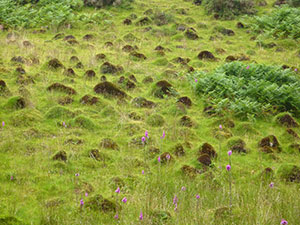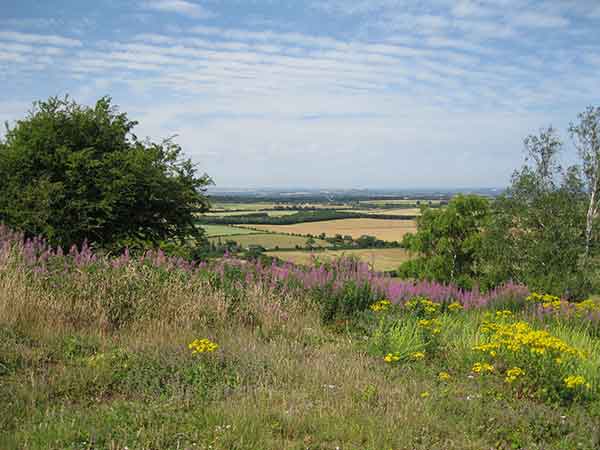Night Ramblings
by Patrick Higgins
Late July found me stumbling down a sunken way with Martha in the pitch dark of a moonless night. Our rough path was hemmed in by ancient yew and beech trees. We were in the Chiltern Hills of South Oxfordshire – an area designated as being of Outstanding Natural Beauty, a Site of Special Scientific Interest and a Special Area of Conservation about 15 minutes from our son’s house in Watlington where we were staying. The broad bottomed ditch we were negotiating dated back to Saxon times. In the darkness with the clinking of key chains and water bottles one could almost hear “the tramp of Saxon foemen, Saxon spearmen, Saxon bowmen” although more commonly this path would have been trampled by generations of Saxon farmers taking their animals to market; merchants with their wares travelling between settlements and woodsmen hauling timber and charcoal.
Further down, the sunken way was bisected by an old Roman road, now resurfaced and travelled by cars. For some unknown reason the Roman routes are always straighter than most of our modern English highways. Behind me, back up the hill, our ditch led to the Ridgeway, Britain’s oldest byway dating back over 5,000 years, which stretched from the Norfolk coast to that of Dorset, linking up Neolithic sites like Stonehenge and Avebury. It’s hard to escape history in England, but we were in search of the glow worm (Lampyris noctiluca), cousins to Fakahatchee’s fireflies in Aston Rowant National Nature Reserve. However, in the dark my mind kept wandering to the Fakahatchee because I had to give a talk locally on the Everglades Ecosystem and was also planning some new night-time interpretive programs for the upcoming season back in Florida.
The Reserve is a mosaic of chalk grassland, beech woodland and Juniper scrub sitting atop 300 feet of chalk, formed 350 million years ago from the compressed calcite shells of microscopic Foraminifera that lived in the warm, shallow seas that once covered southern Britain. Chalk grassland is a unique and fragile habitat, important for both its beauty and wildlife value. It is the product of centuries of grazing by animals on nutrient poor chalk soils and is characterized by a short turf rich in herbs, flowers, butterflies and grasses, and like the Fakahatchee also in orchids, although here they are all terrestrial.
Comparisons between the ecosystems continued to flood my thoughts as we bumped along. In one we employ prescribed burns to maintain the habitat. Here, it’s the grazing of a large flock of speckle-faced sheep and a few Dartmoor ponies that controls the spread of young scrub and keeps chalk grassland healthy.
Aston Rowant, at only some the 500 acres, is a classic example of the threat to biodiversity through islandization and habitat fragmentation. Especially as even this small, precious parcel is sliced into two by a massive cut for the six lane M40 motorway from London to Oxford which paralleled our route just over the rise. It was further affirmation why the Fakahatchee is important; not just because of its unique plant communities, but also as Florida’s largest State Park because of its scale. When it comes to maintaining biodiversity, size does matter!
Back in Florida swallow-tailed kites would just be beginning to assemble for their annual 4,500 mile return migration to South America. Here there were Red kites (Milvus milvus). They had been reduced to just a handful of pairs in Wales through past persecution. It was mistakenly believed that they were a threat to gamebirds and livestock, but recently they have made a remarkable comeback. Through a reintroduction program using chicks taken from northern Spain there are now some 250 breeding pairs in the Chilterns. With a 5 ½ foot wingspan Red kites are a much larger bird than our swallow-tail, weighing 2 – 3 pounds versus 10–20 ounces and their ecological role is different too. Rather than being canopy feeders they are primarily carrion feeders, filling the role of vultures, although they will take small mammals too if caught in the open. The locals who once persecuted them now throw the bones from their Sunday joints out on to the lawn to watch them swoop in, a practice sadly that does not encourage the kites’ dispersal into new territory.

Field of yellow meadow ant mounds. Photo by Phil Champion
In Florida the instant we step off the road we are on the alert for fire ant nests. Here there is an unseen benevolent ant, the Yellow meadow ant (Lasius flavus). The chalk grassland and other undisturbed ancient pasture areas are dotted with myriads of small grassy domes that look almost like neatly planted helmets. These are actually ant-hills, some over a hundred years old. Inside of each is a colony of up to 5,000 meadow ants that feed the by farming the sap sucking aphids that live on the roots of the surrounding forbs and grasses. The ants milk the greenfly for honeydew which they carry back to their colony and in the winter will eat the aphids themselves. Their subterranean activities control damaging insects, open up the soil keeping it porous and their droppings fertilize the grasses’ roots. They also have a curious relationship with the Chalkhill blue butterfly (Polyommatus coridon). Attracted by secretions they will bury the pupa, unintentionally protecting it from predators.

Wingless female glow worm (Lampyris noctiluca). Photo by Barry Crowley
After about 45 minutes bumbling about we finally detected the steady green glow of our target, a glow worm. It was about a foot off the track, naturally in completely the wrong spot deep in the woodland. Glow worms of course are not a worms at all but a bioluminescent beetle just like our related firefly. In their larval stage they are predatory and hunt snails, which why calciferous habitats that favour snails like chalk grasslands are preferred. As adults they rarely feed.
In the glow worm’s case it is only the inch long wingless female that glows significantly. She had climbed up a dried grass stem about 12 inches above the ground then curled her abdomen slightly upward to display the last few segments of her abdomen where her glowing organs are located in hope of attracting a passing male. Unlike American fireflies she can’t readily turn her glow on and off – it’s rather like a very slow starting fluorescent tube, which takes about 20 minutes to cycle so they don’t flash. Misplaced deep in the woods she would be very lucky to have any success. As well as attracting a mate, the glowing abdomen is a warning to predators to stay away – bioluminescent chemicals taste bad.
Nevertheless, hers is a very efficient light source. Unlike incandescent light bulbs that only, transform about 3% of the energy used into light, bioluminescence is generally 90 to 98% efficient. The light is produced by a reaction between calcium, luciferin and ATP in the presence of the catalyst luciferase and oxygen, using nitric oxide as a chemical on/off oxygen valve. It is the switching on and off of the oxygen flow which allows American fireflies to flash. Specific flash patterns are used to identify other members of their species, as well as members of the opposite sex and even. In the case of some Photuris fireflies, it is to mimic the light signals of other firefly species to lure, kill, and eat them. Studies of America’s most common Photinus species show that females are more attracted to males that flash longer and faster. A flash can bring either sex or death! We shall be trying a bit of mimicry ourselves on our moonlight tram rides down Jane’s Scenic Drive this season to see if we can attract any eager males. It’s just a case of getting the response timing right.
Anyways, that solitary glow worm by the trail was the only one we saw that night. We scoured the open grassland to no avail. I guess we missed the peak by about a week, but even then observers were only seeing a dozen specimens a night on this site. Light pollution as well as habitat loss is taking a toll on these interesting insects. We’re pretty lucky in the Fakahatchee.

